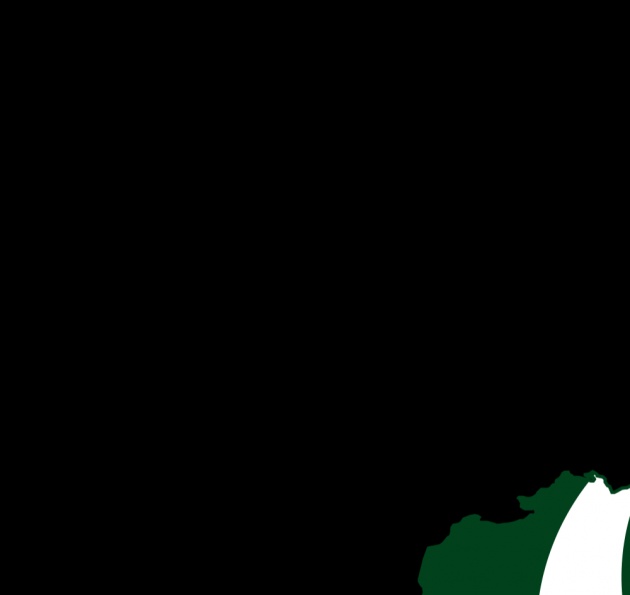Pakistan
Pakistan ( i/ˈpækᵻstæn/ or i/pɑːkiˈstɑːn/; Urdu: پاكستان ALA-LC: Pākistān,pronounced [pɑːkɪst̪ɑːn] ( listen)), officially the Islamic Republic of Pakistan (Urdu: اسلامی جمہوریہ پاكستان ALA-LC: Islāmī Jumhūriyah Pākistān IPA: [ɪslɑːmiː d͡ʒʊmɦuːriəɪh pɑːkɪst̪ɑːn]),[1] is a country in South Asia. It is the sixth-most populous country with a population exceeding 199 million people.[13] It is the 36th largest country in the world in terms of area with an area covering 881,913 km2 (340,509 sq mi). Pakistan has a 1,046-kilometre (650 mi) coastline along the Arabian Sea and the Gulf of Oman in the south and is bordered by India to the east, Afghanistan to the west, Iran to the southwest and China in the far northeast respectively. It is separated fromTajikistan by Afghanistan's narrow Wakhan Corridor in the north, and also shares a maritime border with Oman.
The territory that now constitutes Pakistan was previously home to several ancient cultures, including the Mehrgarh of the Neolithic and the Bronze Age Indus Valley Civilisation, and was later home to kingdoms ruled by people of different faiths and cultures, including Hindus, Indo-Greeks,Muslims, Turco-Mongols, Afghans and Sikhs. The area has been ruled by numerous empires and dynasties, including the Indian Mauryan Empire, the Persian Achaemenid Empire, Alexander of Macedonia, the Arab Umayyad Caliphate, the Mongol Empire, the Mughal Empire, the Durrani Empire, the Sikh Empire and the British Empire. As a result of the Pakistan Movement led byMuhammad Ali Jinnah and the subcontinent's struggle for independence, Pakistan was created in 1947 as an independent nation for Muslims from the regions in the east and west of the Subcontinent where there was a Muslim majority. Initially a dominion, Pakistan adopted a new constitution in 1956, becoming an Islamic republic. A civil war in 1971 resulted in the secession ofEast Pakistan as the new country of Bangladesh.
Pakistan is a federal parliamentary republic consisting of four provinces and four federal territories. It is an ethnically and linguistically diverse country, with a similar variation in its geography andwildlife. A regional and middle power,[18][19] Pakistan has the seventh largest standing armed forcesin the world and is also a nuclear power as well as a declared nuclear-weapons state, being the only nation in the Muslim world, and the second in South Asia, to have that status. It has a semi-industrialised economy with a well-integrated agriculture sector, its economy is the 26th largest in the world in terms of purchasing power and 45th largest in terms of nominal GDP and is also characterized among the emerging and growth-leading economies of the world.[20][21]
The post-independence history of Pakistan has been characterised by periods of military rule, political instability and conflicts with neighbouring India. The country continues to face challenging problems, including overpopulation, terrorism, poverty, illiteracy, and corruption. Despite these factors it maintains strategic endowments and development potential while it has made substantial progress in reducing poverty giving it the second lowest headcount poverty rate in South Asia.[22] It is ranked 16th on the 2012 Happy Planet Index,[23] while its stock exchange has been among the highest performing in Asia.[24] It is a member of the United Nations, the Commonwealth of Nations, the Next Eleven Economies, Shanghai Cooperation Organisation, ECO, UfC, D8, Cairns Group,Kyoto Protocol, ICCPR, RCD, UNCHR, Asian Infrastructure Investment Bank, Group of Eleven,CPFTA, Group of 24, the G20 developing nations, ECOSOC, founding member of the Organisation of Islamic Cooperation, SAARC and CERN.[25]
Etymology
The name Pakistan literally means "Land of the Pure" in Urdu and Persian. It comes from the word pāk meaning pure in Persian and Pashto[26]while the word istān is a Persian word meaning place of; it is a cognate of the Sanskrit word sthāna (Devanagari: स्थान [st̪ʰaːnə]).[27]
It was coined in 1933 as Pakstan by Choudhry Rahmat Ali, a Pakistan Movement activist, who published it in his pamphlet Now or Never,[28]using it as an acronym ("thirty million Muslim brethren who live in PAKSTAN") referring to the names of the five northern regions of the British Raj: Punjab, Afghania, Kashmir, Sindh, and Baluchistan".[29][30][31] The letter i was incorporated to ease pronunciation and form the linguistically correct and meaningful name.[32]
History
Main article: History of Pakistan
See also: Outline of South Asian history
You may need rendering support to display the Urdu text in this article correctly.
Early and medieval age
Main articles: Indo-Greek Kingdom, Indus Valley Civilization, Vedic Civilization, Sikh Empire andMughal Empire
Standing Buddha fromGandhara
Some of the earliest ancient human civilisations in South Asia originated from areas encompassing present-day Pakistan.[33] The earliest known inhabitants in the region were Soanian during the Lower Paleolithic, of whom stone tools have been found in the Soan Valley of Punjab.[34] The Indus region, which covers most of Pakistan, was the site of several successive ancient cultures including the Neolithic Mehrgarh[35] and the Bronze Age Indus Valley Civilisation (2800–1800 BCE) at Harappa and Mohenjo-Daro.[36][37]
The Vedic Civilization (1500–500 BCE), characterised by Indo-Aryan culture, laid the foundations of Hinduism, which would become well established in the region.[38][39] Multan was an important Hindu pilgrimage centre.[40] The Vedic civilisation flourished in the ancient Gandhāran city of Takṣaśilā, now Taxila in Punjab.[35] Successive ancient empires and kingdoms ruled the region: the Persian Achaemenid Empire around 519 BCE, Alexander the Great's empire in 326 BCE[41] and the Maurya Empire founded by Chandragupta Maurya and extended by Ashoka the Great until 185 BCE.[35] The Indo-Greek Kingdom founded by Demetrius of Bactria (180–165 BCE) included Gandhara and Punjab and reached its greatest extent under Menander (165–150 BCE), prospering the Greco-Buddhist culture in the region.[35][42] Taxila had one of the earliest universities and centres of higher education in the world.[43][44][45][46]
The Medieval period (642–1219 CE) is defined by the spread of Islam in the region. During this period, Sufimissionaries played a pivotal role in converting a majority of the regional Buddhist and Hindu population to Islam.[47] The Rai Dynasty (489–632 CE) of Sindh, at its zenith, ruled this region and the surrounding territories.[48] The Pala Dynasty was the last Buddhist empire that underDharampala and Devapala stretched across South Asia from what is now Bangladesh through Northern India to Pakistan and later to Kambojregion in Afghanistan.
The Arab conqueror Muhammad bin Qasim conquered Indus valley from Sindh to Multan in southern Punjab in 711 CE.[49][50][51][52][53] The Pakistan government's official chronology identifies this as the point where the "foundation" of Pakistan was laid.[49][54][55] This conquest set the stage for the rule of several successive Muslim empires in the region, including the Ghaznavid Empire (975–1187 CE), the Ghorid Kingdom and the Delhi Sultanate (1206–1526 CE). The Lodi dynasty, the last of the Delhi Sultanate, was replaced by the Mughal Empire (1526–1857 CE). The Mughals introduced Persian literature and high culture, establishing the roots of Indo-Persian culture in the region.[56] In the early 16th century, the region remained under the Mughal Empire ruled by Muslim emperors.[57] By the early 18th century, the increasing European influence slowly disintegrated the empire as the lines between commercial and political dominance were increasingly blurred.[57]
Edwin Lord Weeks illustration of an open-air restaurant near Wazir Khan Mosque, Lahore.
During this time, the English East India Company, had established coastal outposts.[57] Control over the seas, greater resources, technology, and military force projection by East India Company of British Empire led it to increasingly flex its military muscle; a factor that was crucial in allowing the Company to gain control over subcontinent by 1765 and sidelining the European competitors.[58] Expanding access beyond Bengal and the subsequent increased strength and size of its army enabled it to annex or subdue most of region by the 1820s.[57] To many historians, this marked the starting of region's colonial period.[57] By this time, with its economic power severely curtailed by the British parliament and itself effectively made an arm of British administration, the Company began to more consciously enter non-economic arenas such as education, social reform, and culture.[57] Such reforms included the enforcement of English Education Act in 1835 and the introduction of the Indian Civil Service (ICS).[59]Traditional madrasahs – primary institutions of higher learning for Muslims in the subcontinent – were no longer supported by the English Crown, and nearly all of the madrasahs lost their financial endowment.[60]
Colonial period
Main articles: Pakistan Movement, Aligarh Movement and British Raj
Sir Syed Ahmad Khan (1817-98) whose visionformed the basis of Pakistan
Muhammad Ali Jinnah (1876–1948) served as Pakistan's first Governor-General and the leader of thePakistan Movement
The gradual decline of the Mughal Empire in the early 18th century enabled the Sikh Empire's influence to control larger areas until the British East-India Company gained ascendancy over the Indian subcontinent.[61] The rebellion in 1857 (or Sepoy mutiny) was the region's major armed struggle against theBritish Empire and Queen Victoria.[62] Divergence in the relationship between Hinduism and Islam created a major rift in British India; thus instigating racially motivated religious violence in India.[63] The language controversy further escalated the tensions between Hindus and Muslims.[64] The Hindu renaissancewitnessed the awakening of intellectualism in traditional Hinduism and saw the emergence of more assertive influence in the social and political spheres in British India.[65][66] Intellectual movement to counter the Hindu renaissance was led by Sir Syed Ahmad Khan who helped founding the All-India Muslim League in 1901 and envisioned as well as advocated for the two-nation theory.[61] In contrast to the Indian Congress's anti-Britishefforts, the Muslim League was a pro-British whose political program inherited the British values that would shape Pakistan's future civil society.[67][68] In events during World War I, British Intelligence foiled an anti-English conspiracy involving the nexus of Congress and the German Empire.[69] The largely non-violent independence struggle led by the Indian Congress engaged millions of protesters in mass campaigns of civil disobedience in the 1920s and 1930s against the British Empire.[70][71][72]
Over 10 million people were uprooted from their homeland and travelled on foot, bullock carts and trains to their promised new home during the Partition of India. During the partition between 200,000 to 500,000 people were killed in the retributive genocide.[73]
The Muslim League slowly rose to mass popularity in the 1930s amid fears of under-representation and neglect of Muslims in politics. In his presidential address of 29 December 1930, Allama Iqbal called for "the amalgamation of North-West Muslim-majority Indian states" consisting of Punjab, North-West Frontier Province, Sind and Baluchistan.[74] Muhammad Ali Jinnah, the founder of Pakistan, greatly espoused the two-nation theory and led the Muslim League to adopt the Lahore Resolution of 1940, popularly known as the Pakistan Resolution.[61] In World War II, Jinnah and British educated founding fathers in the Muslim League supported the United Kingdom's war efforts, countering opposition against it whilst working towards Sir Syed's vision.[75]
As the cabinet mission failed in India, the Great Britain announced the intentions to end its raj in India in 1946–47.[76] Nationalists in British India – including Jawaharlal Nehru and Abul Kalam Azadof Congress, Jinnah of Muslim League, and Master Tara Singh representing the Sikhs—agreed to the proposed terms of transfer of power and independence in June 1947.[77] As the United Kingdomagreed upon partitioning of India in 1947, the modern state of Pakistan was established on 14 August 1947 (27th of Ramadan in 1366 of the Islamic Calendar) in amalgamating the Muslim-majorityeastern and northwestern regions of British India.[72] It comprised the provinces of Balochistan, East Bengal, the North-West Frontier Province, West Punjab and Sindh; thus forming Pakistan.[61][77] The partitioning of Punjab and Bengal led to the series of violent communal riots across India and Pakistan; millions of Muslims moved to Pakistan and millions of Hindus and Sikhs moved to India.[78] Dispute over Jammu and Kashmir led to the First Kashmir War in 1948



